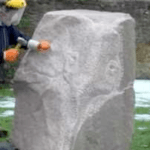Creating Art, Creating Change
 I was thinking about the approach an artist might take when creating a granite sculpture. Starting with a block of granite, they assess the material, determine strengths and weaknesses, and consider the best approach to realize their vision for what it is to become. Each stone is unique and plays a part in determining the path required to produce fine art.
I was thinking about the approach an artist might take when creating a granite sculpture. Starting with a block of granite, they assess the material, determine strengths and weaknesses, and consider the best approach to realize their vision for what it is to become. Each stone is unique and plays a part in determining the path required to produce fine art.
As the artist begins, they often remove large chunks of granite before they begin a more incremental approach for creating the final form. They iteratively remove material and continue to inspect and adapt as they uncover weaknesses or find beautiful material. They adapt as they learn and embrace change as they continue their journey. Always mindful of the material at hand, they drive towards their vision for the art.
I think this might be an interesting analogy for introducing change into an organization. Implementing change into an organization, such as an agile transformation, requires a clear understanding of the material we will work with. Who will be impacted, what is the current structure, is there support for the vision, where are the strengths and weaknesses? An assessment can help provide answers to these questions. With that said, just as the artist only sees the surface of the granite, an assessment only provides an outside view. It is all we have to start with and with this knowledge we create a vision and approach for change.
Change is hard and as with the the original piece of granite, we may need to remove large chunks to create the structure required for change. With a visible structure we continue with an incremental and iterative approach for realizing the original vision. As the organization responds to change there is a continuous inspect and adapt cycle at play as we continue to fine tune. Strengths are leveraged and weakness diminished. We will continue to uncover unique characteristics about the organization which influences ongoing work required to realize the vision.
Creating a granite sculpture takes time and a willingness to adapt to unique characteristics of the stone. Change requires structure, patience, and a willingness to inspect and adapt as we make the journey to goal.

Comments (4)
Rick Mc
It also takes a hammer and a really sharp chisel.
@Rick – Having the right tools does certainly help ;-)
Mike Cottmeyer
I think the metaphor holds even further. Initially, during the early stages of the transformation, we are making significant progress, but the sculpture is not in it’s final form. Sure, it looks more like a statue than a block of granite, but there is a ton of work left to do. If we stop our work before the sculpture is complete, we will not have received the value from our initial investment.